Anatomy and Physiology II - Section 3, Lesson 5
1/96
There's no tags or description
Looks like no tags are added yet.
Name | Mastery | Learn | Test | Matching | Spaced |
|---|
No study sessions yet.
97 Terms
Q: What is the stomach?
A: A large, distensible muscular sac located to the left of the upper abdomen, immediately below the diaphragm.
Q: What are the three major functions of the stomach?
A:
Acts as a mixing compartment, breaking up food into a semi-fluid pulp called chyme.
Functions as a storage organ, holding up to 1500 ml (4 liters) of food.
Secretes gastric juice, which contains water, mucus, hydrochloric acid, intrinsic factor, and pepsinogen for chemical digestion.
Q: How long can food remain in the stomach?
A: Food can remain in the stomach for 2–4 hours, depending on the nature of the food and the muscularity of the stomach.
Q: What does the stomach secrete that contributes to digestion?
A: The stomach secretes gastric juice, which includes water, mucus, hydrochloric acid, intrinsic factor, and pepsinogen.
Q: How does the stomach contribute to digestion?
A: The stomach is a mixing and storage compartment where food is broken down, mixed with digestive juices, and converted into chyme.
Q: What happens to the size of the stomach after eating?
A: The stomach can stretch to hold up to 4 liters of food and fluid, more than 75 times its resting size when empty, and then return to its normal size once empty.
Q: Does body weight correlate with stomach size?
A: No, body weight does not correlate with stomach size. The stomach stretches based on the quantity of food eaten, not the individual’s weight.
Q: What is the primary function of the stomach regarding food digestion?
A: The stomach serves as a temporary holding chamber, storing food and releasing small amounts of chyme into the small intestine at a time.
Q: What is chyme?
A: Chyme is the semi-fluid pulp that food is converted into in the stomach, which is then released into the small intestine.
Q: What types of digestion occur in the stomach?
A: The stomach continues carbohydrate digestion and begins protein and triglyceride digestion.
Q: What is the primary function of the stomach in terms of nutrient absorption?
A: Very little nutrient absorption occurs in the stomach, except for small amounts of alcohol.
Q: What are the four main regions of the stomach?
A: The cardia, fundus, body, and pylorus.
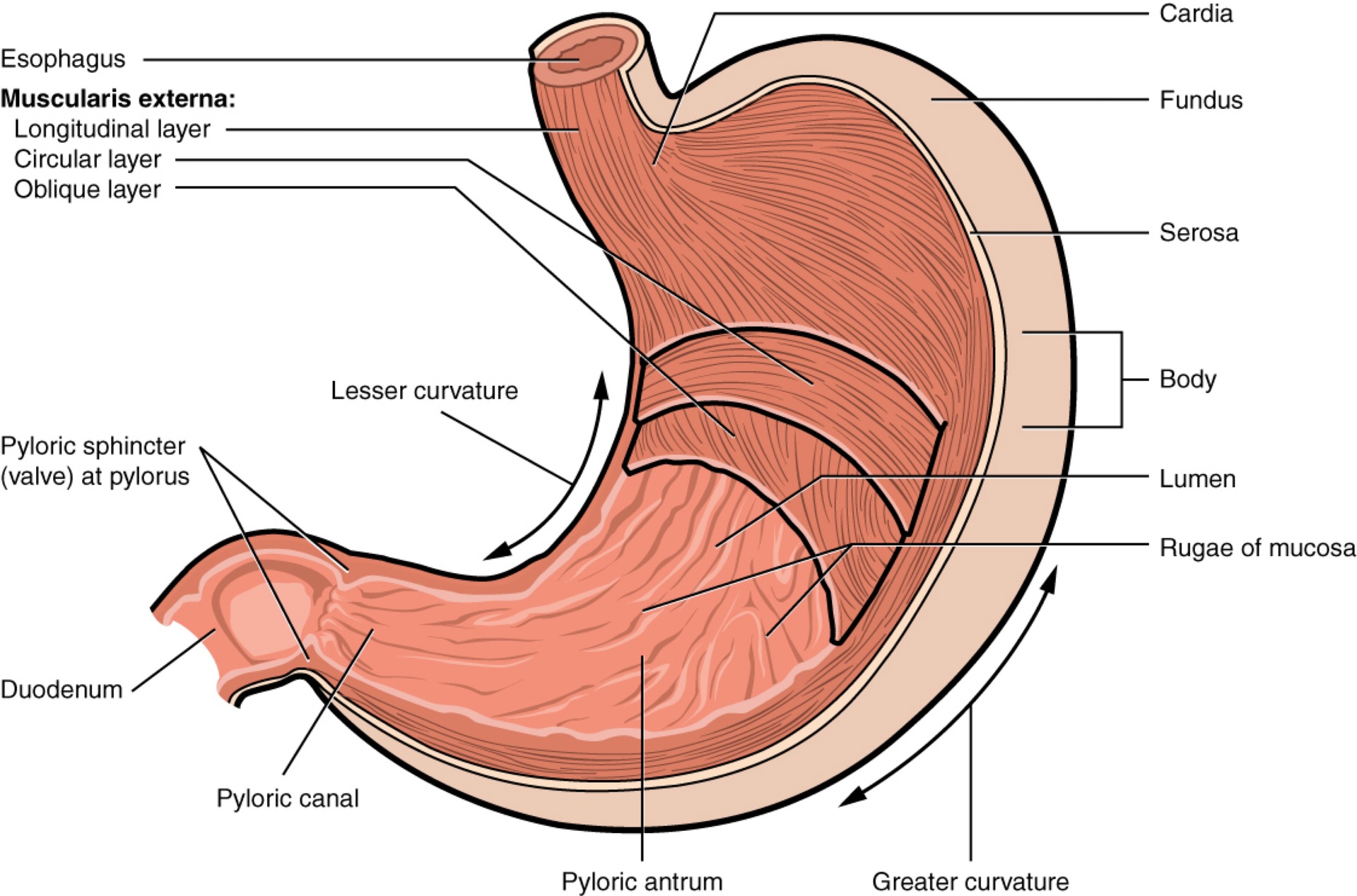
Q: What is the cardia of the stomach?
A: The cardia (or cardiac region) is the point where the esophagus connects to the stomach and through which food passes into the stomach.

Q: Where is the fundus of the stomach located?
A: The fundus is located above and to the left of the cardia, inferior to the diaphragm, and is dome-shaped.
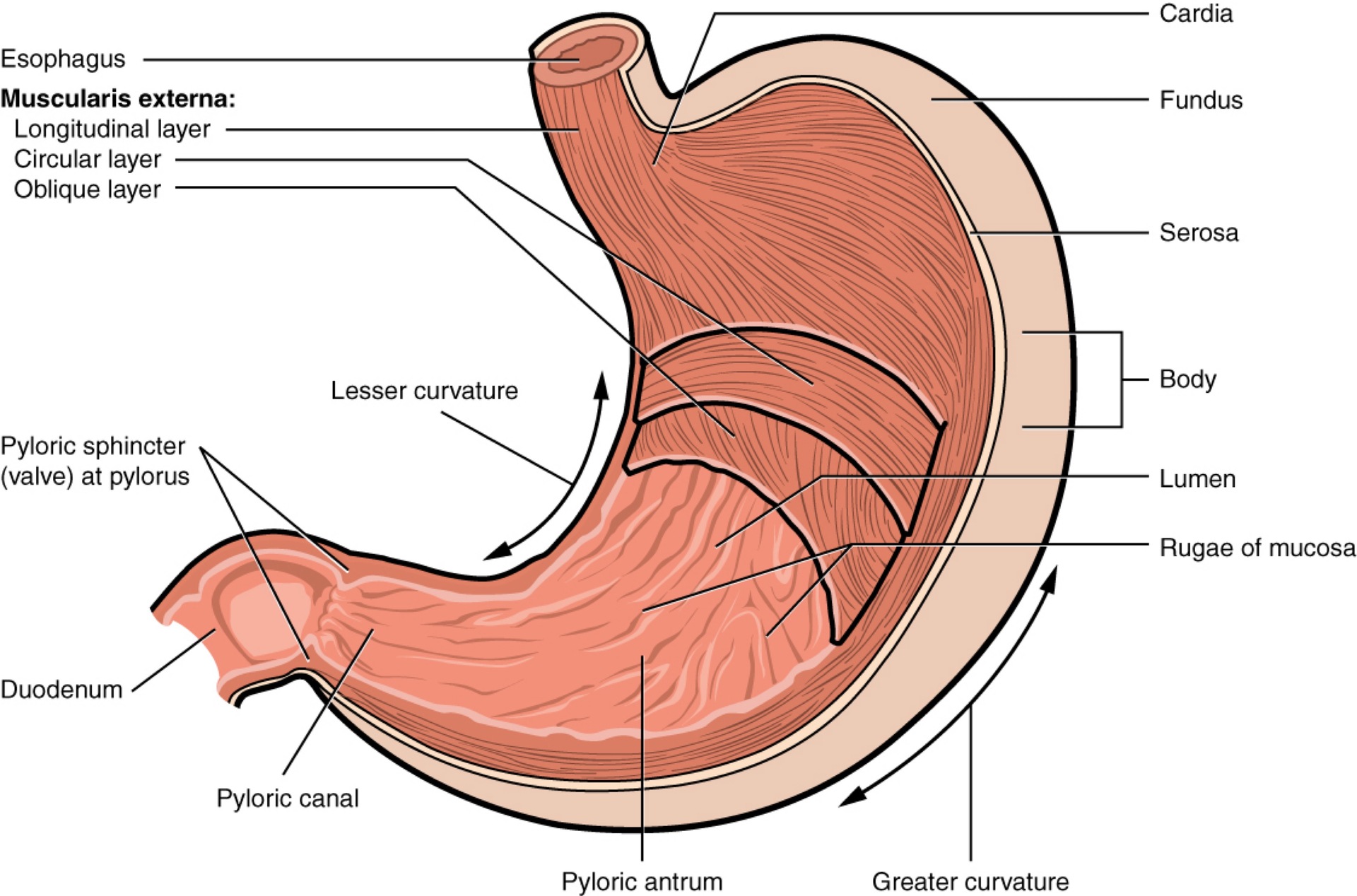
Q: What is the body of the stomach?
A: The body is the main part of the stomach, located below the fundus.
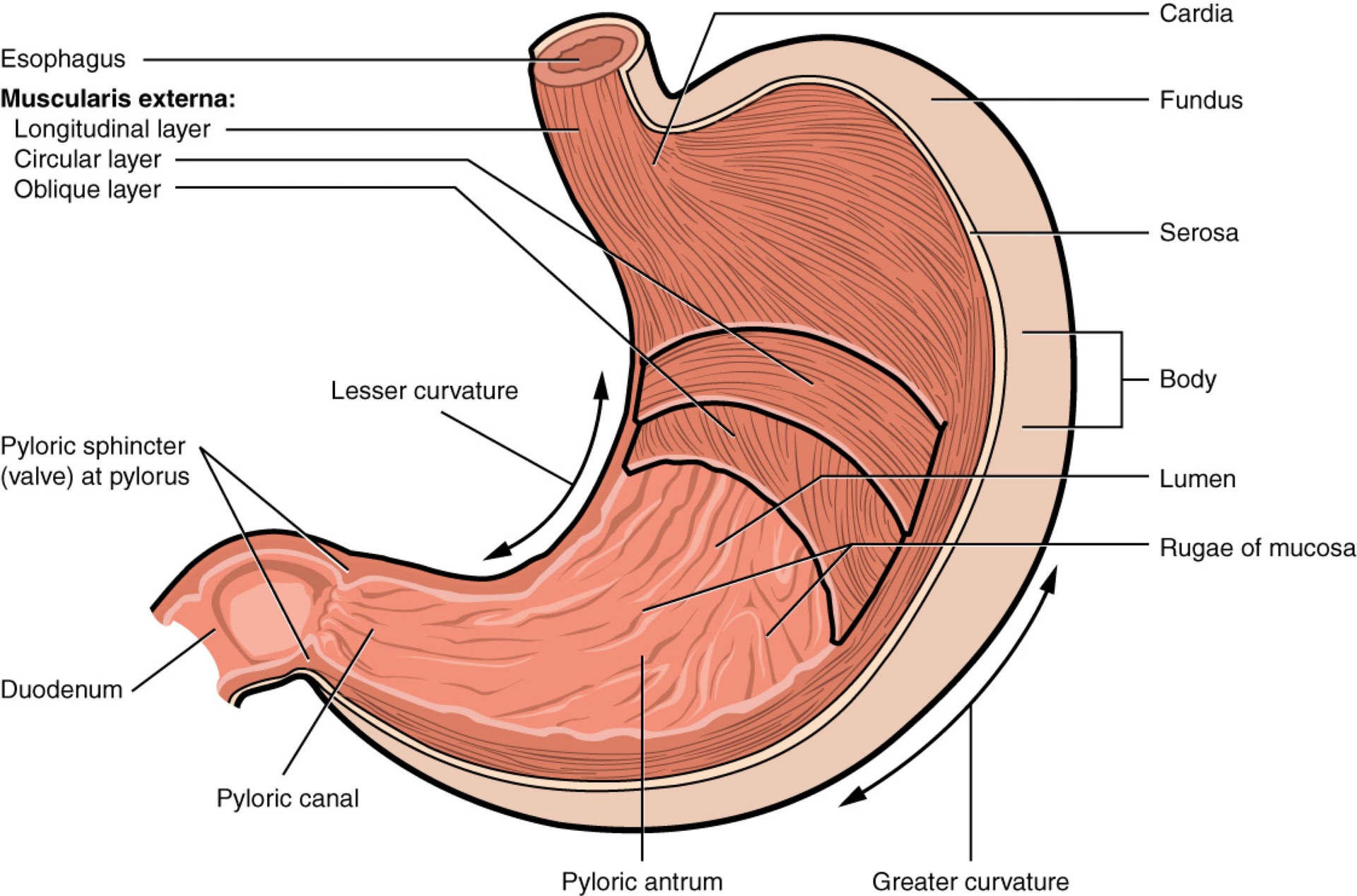
Q: What is the pylorus of the stomach?
A: The pylorus is the funnel-shaped region of the stomach that connects the stomach to the duodenum.
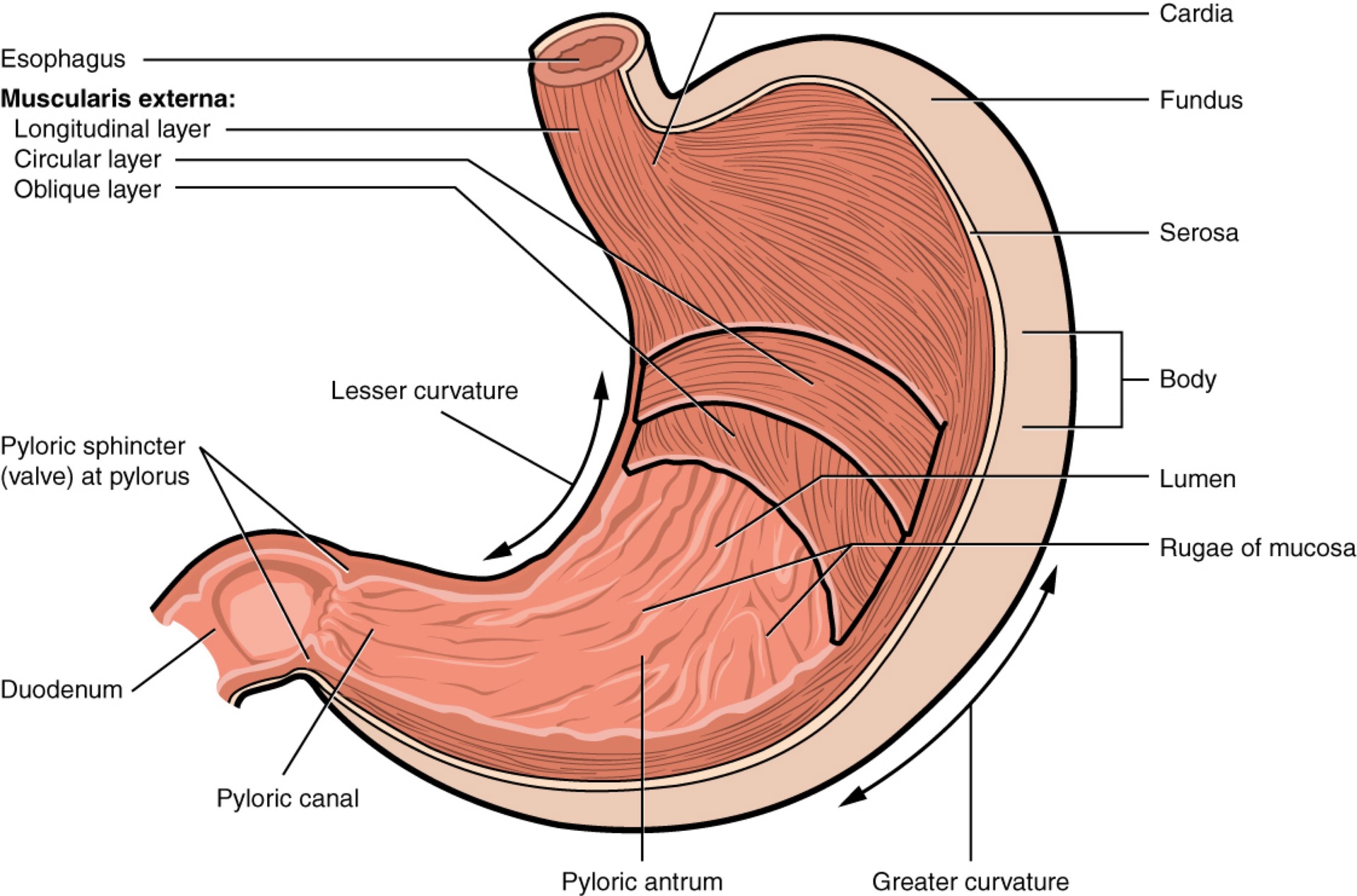
Q: What is the pyloric antrum?
A: The pyloric antrum is the wider end of the pylorus that connects to the body of the stomach.

Q: What is the pyloric canal?
A: The pyloric canal is the narrower end of the pylorus that connects to the duodenum.
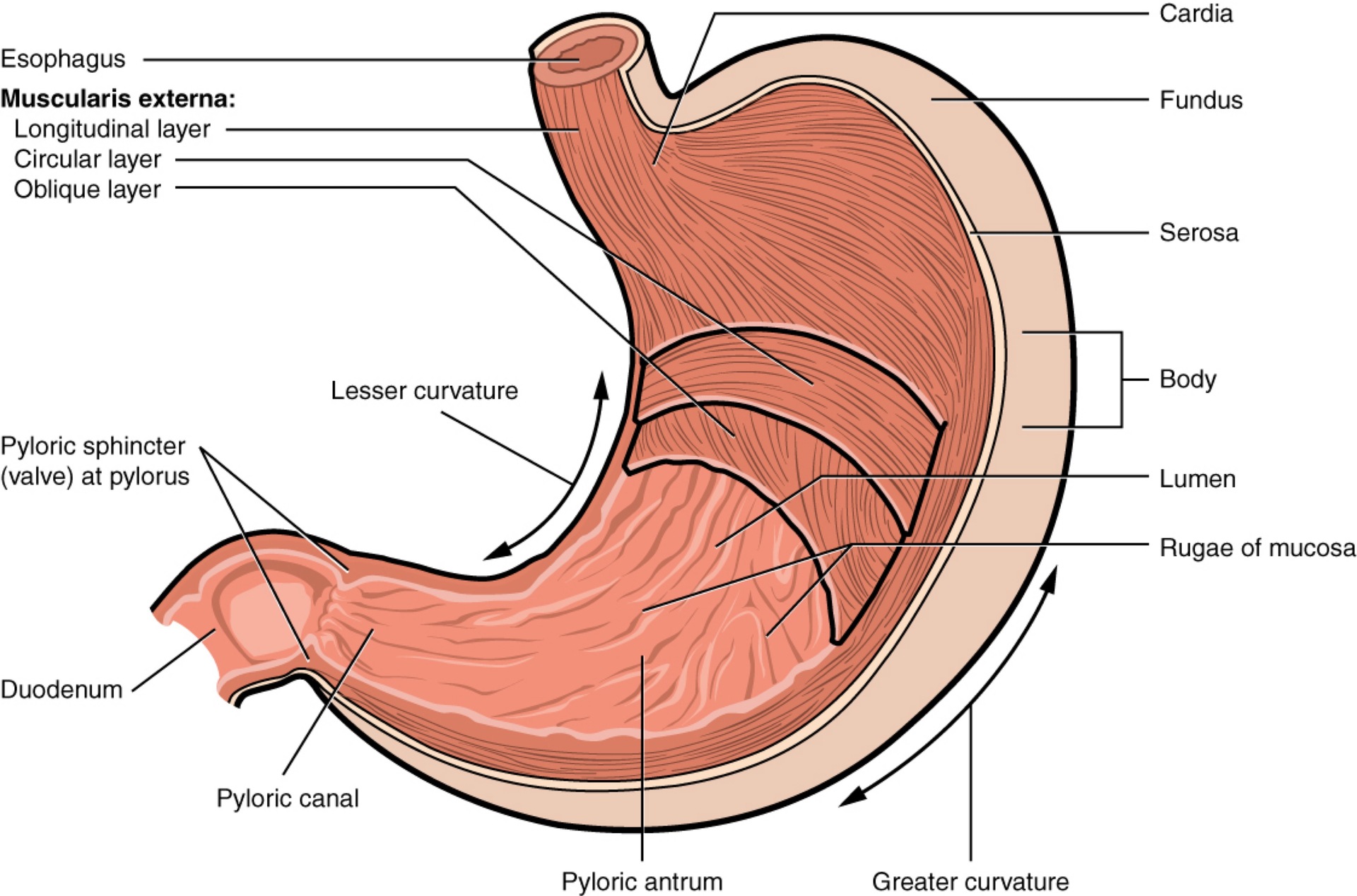
Q: What is the function of the pyloric sphincter?
A: The pyloric sphincter is smooth muscle located at the end of the pyloric canal that controls stomach emptying by regulating the passage of chyme into the duodenum.
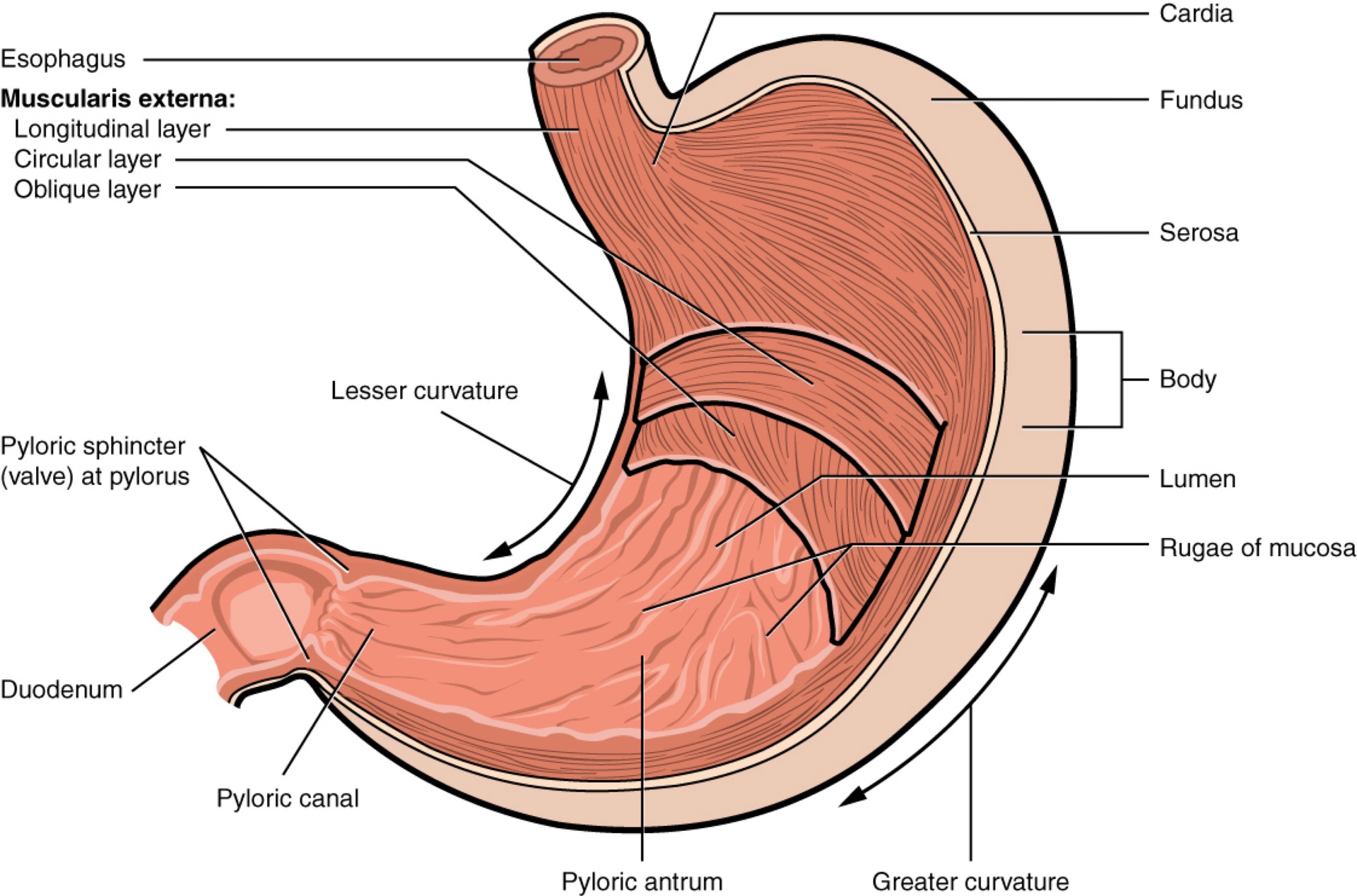
Q: What happens to the stomach when it is empty?
A: In the absence of food, the stomach deflates inward, and its mucosa and submucosa form large folds called rugae.
Q: What is the greater curvature of the stomach?
A: The greater curvature is the convex lateral surface of the stomach.
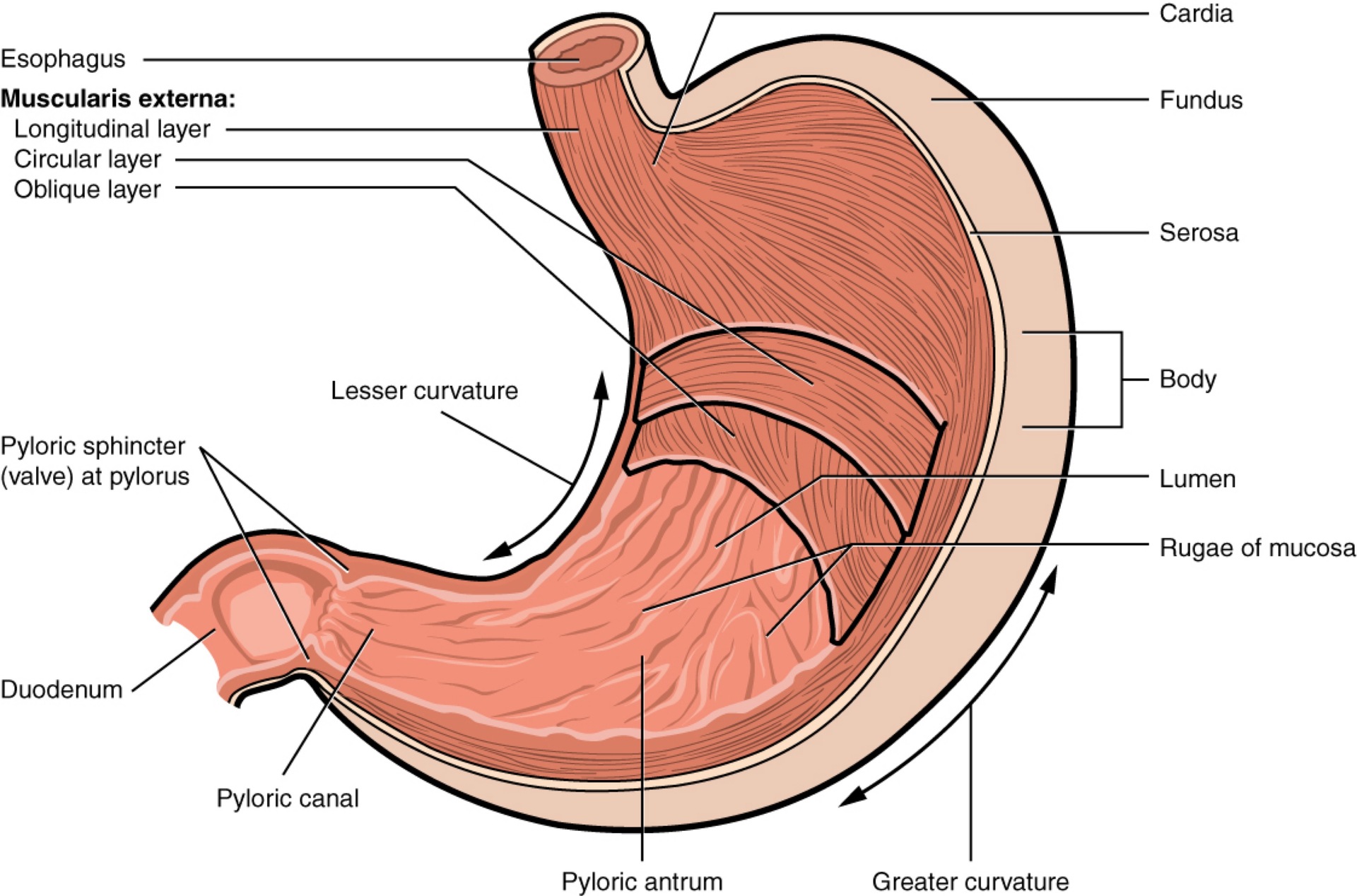
Q: What is the lesser curvature of the stomach?
A: The lesser curvature is the concave medial border of the stomach.
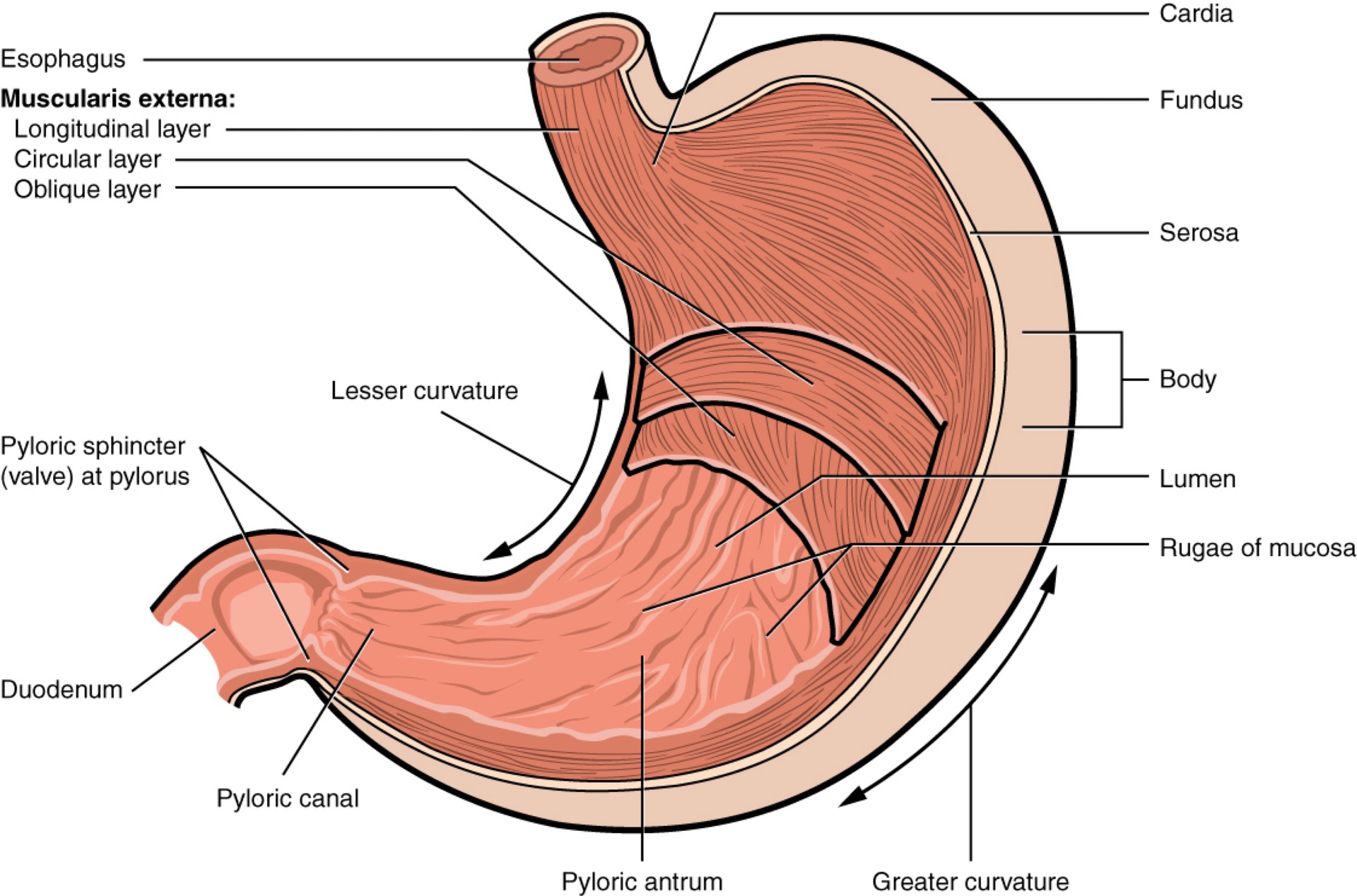
Q: What is the lesser omentum?
A: The lesser omentum is a fold of peritoneum that extends from the liver to the lesser curvature of the stomach, helping to hold the stomach in place.
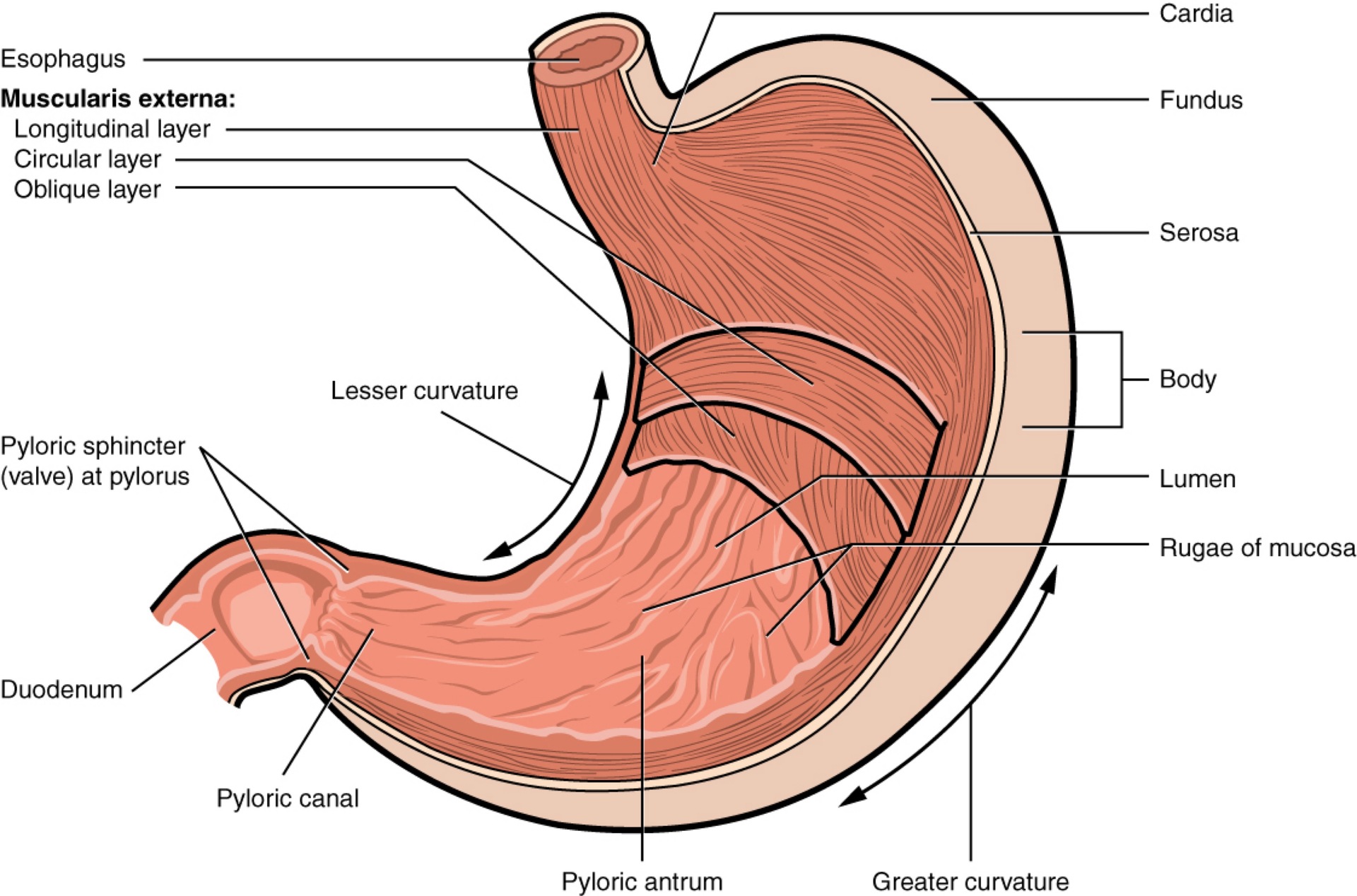
Q: What is the greater omentum?
A: The greater omentum is a fold of peritoneum that extends from the greater curvature of the stomach to the posterior abdominal wall, also helping to hold the stomach in place.

Q: What is chyme?
A: Chyme is a soupy liquid created when food is mixed with digestive juices in the stomach, forming a semi-fluid pulp.
Q: What is hydrochloric acid in the stomach?
A: Hydrochloric acid is an aqueous solution of hydrogen chloride present in gastric juice, aiding in digestion by lowering the pH of the stomach.
Q: What is the role of intrinsic factor in digestion?
A: Intrinsic factor is a protein made by the cells in the stomach lining that helps the intestines absorb vitamin B12.
Q: What is pepsinogen?
A: Pepsinogen is the inactive form of pepsin, an enzyme in the stomach that aids in protein digestion.
Q: What is the cardiac region (also known as the cardia) of the stomach?
A: The cardiac region (or cardia) is the upper part of the stomach where the bolus enters from the esophagus.
Q: What is the function of the lower esophageal sphincter?
A: The lower esophageal sphincter is a bundle of muscles at the junction of the stomach and esophagus, preventing acid reflux and controlling the movement of food into the stomach.
Q: What is the fundus of the stomach?
A: The fundus is the dome-shaped upper part of the stomach situated just above the junction with the esophagus.
Q: What is the body of the stomach?
A: The body is the middle part of the stomach, where most digestion occurs.
Q: What is the pylorus of the stomach?
A: The pylorus is the lower, funnel-shaped part of the stomach that is continuous with the duodenum.
Q: What is the pyloric antrum?
A: The pyloric antrum is the start of the pyloric part of the stomach, leading toward the pyloric canal.
Q: What is the pyloric canal?
A: The pyloric canal is the cavity inside the pyloric segment that opens through the pyloric sphincter into the duodenum.
Q: What is the function of the pyloric sphincter?
A: The pyloric sphincter is a band of smooth muscle at the end of the pyloric canal that controls the movement of partially digested food and juices from the pylorus into the duodenum.
Q: What are the four layers that make up the wall of the stomach?
A: The wall of the stomach is made up of the mucosa, submucosa, muscularis, and serosa.
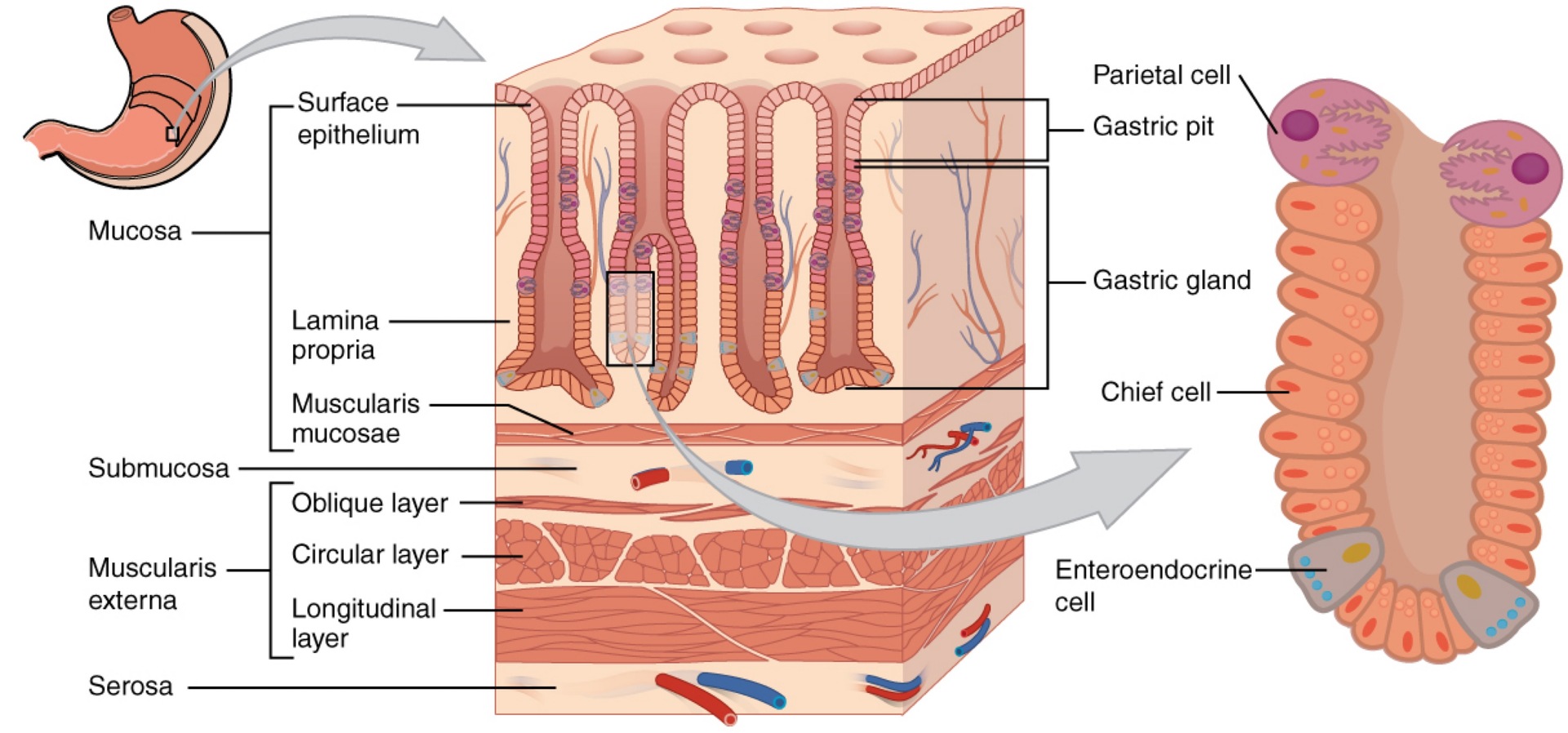

Q: What adaptations are found in the muscularis of the stomach?
A: The muscularis layer of the stomach has an additional inner oblique smooth muscle layer, in addition to the typical circular and longitudinal smooth muscle layers.
Q: How does the muscularis of the stomach help in digestion?
A: The muscularis allows the stomach to churn food, breaking it down into smaller particles while also moving food through the alimentary canal.
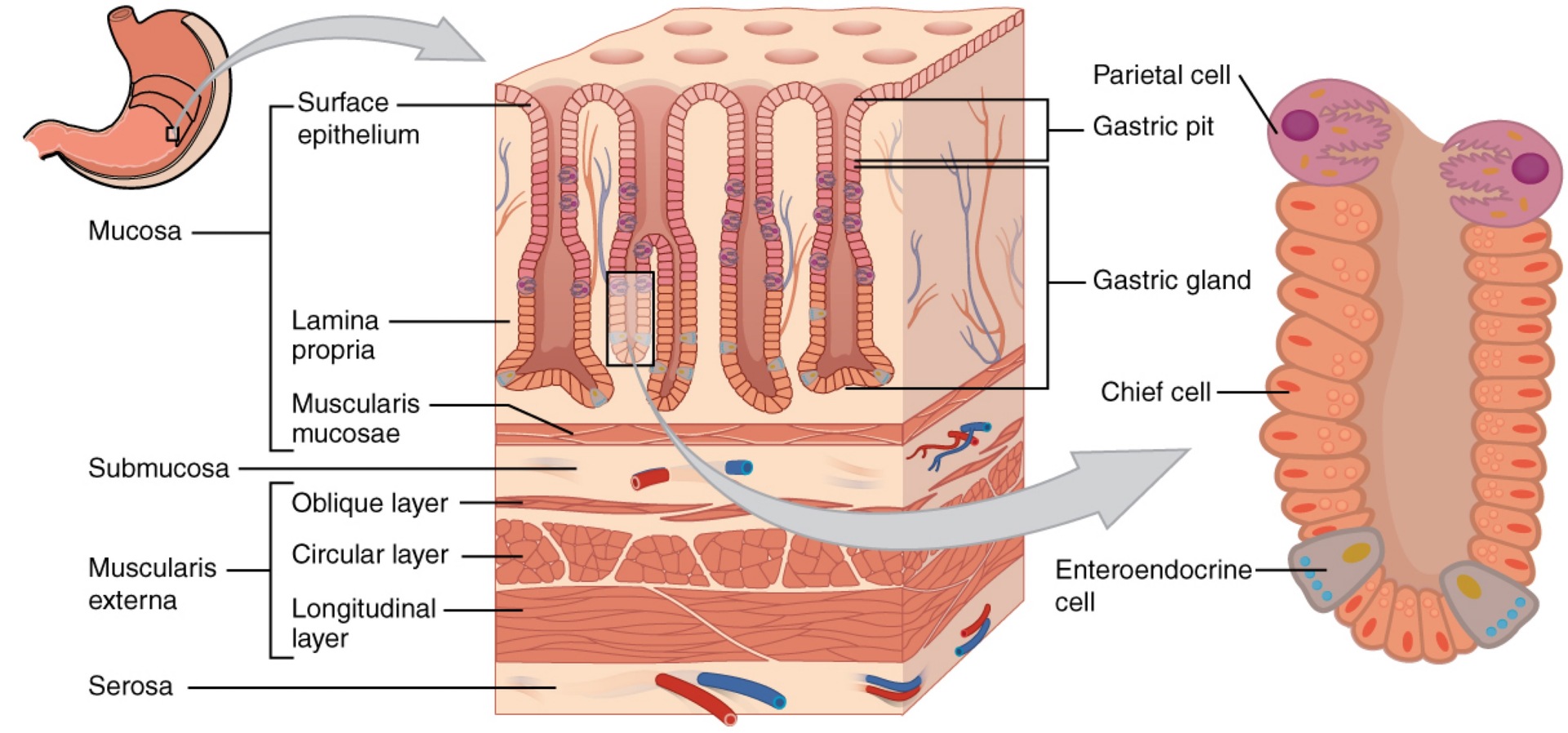
Q: What is the role of the mucosa layer in the stomach?
A: The mucosa is the innermost layer that contains cells that secrete digestive enzymes and acid, and it also protects the stomach lining from digestive juices.
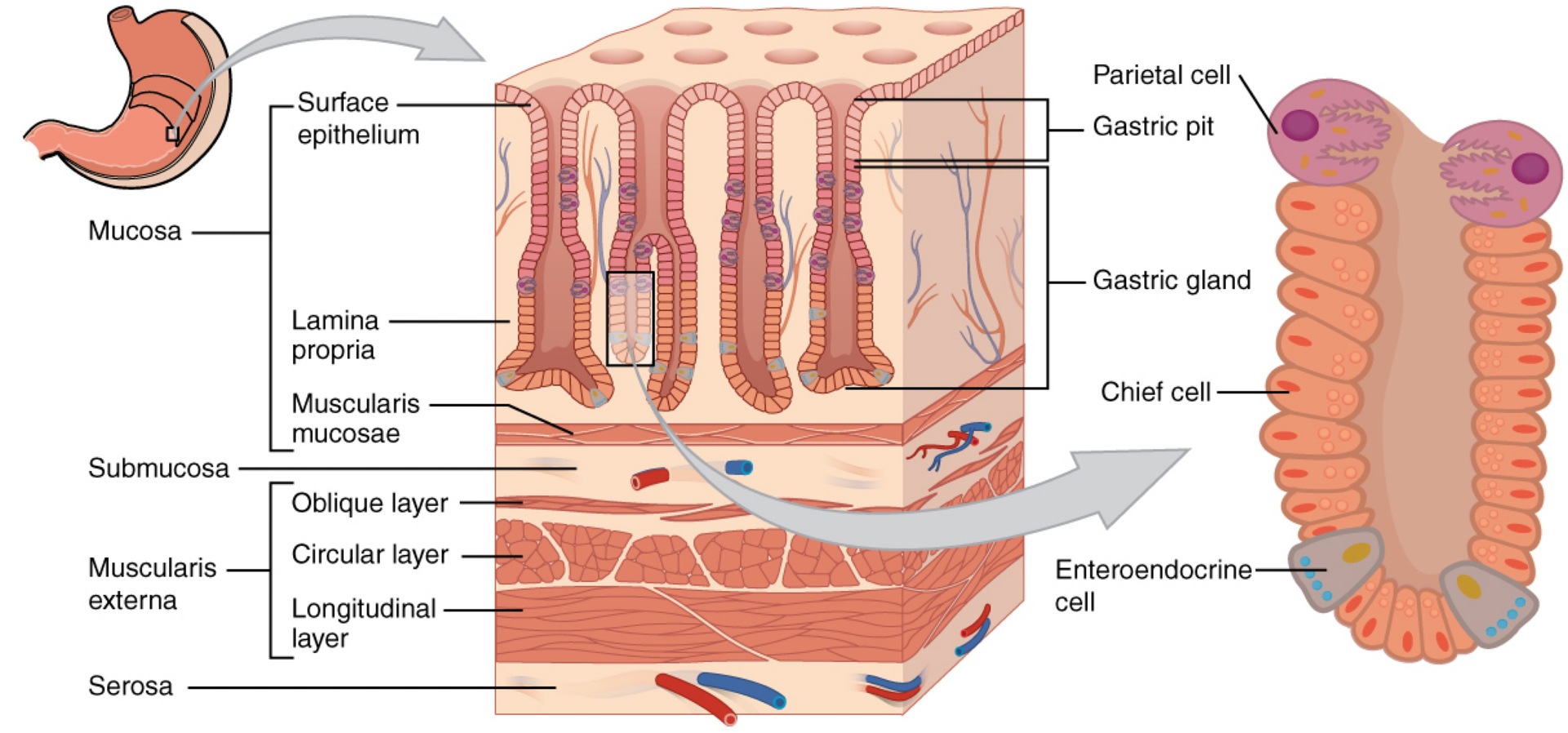
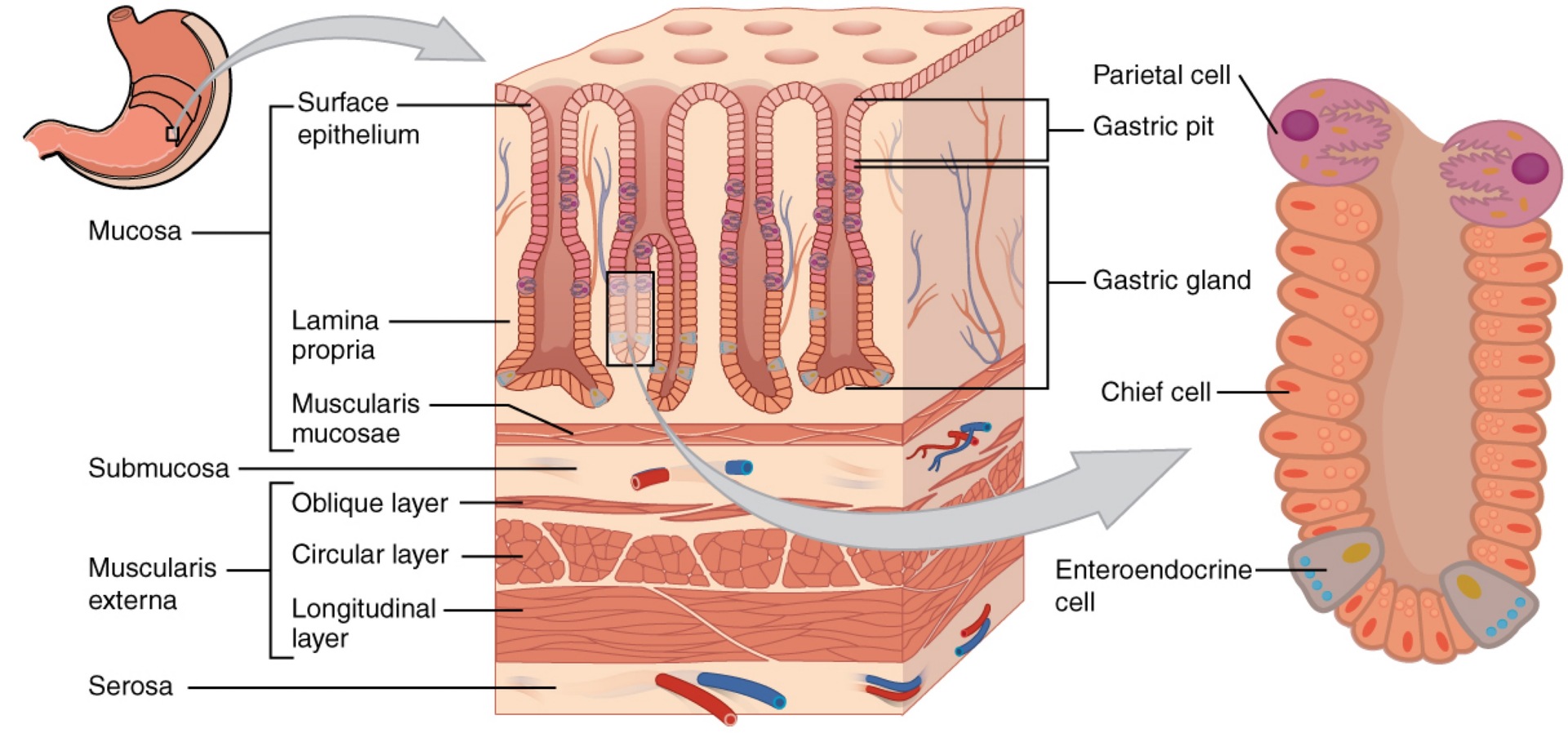
Q: What is the purpose of the serosa layer in the stomach?
A: The serosa is the outermost layer, providing a smooth surface and secreting a lubricating fluid that reduces friction between the stomach and surrounding structures.
Q: What is the main function of the gastric pits in the stomach?
A: Gastric pits lead to gastric glands that secrete gastric juice, essential for digestion.
Q: What is the role of the epithelial lining of the stomach?
A: The epithelial lining consists of surface mucus cells that secrete a protective alkaline mucus to protect the stomach from its own acidic digestive juices.
Q: What cells are found in the gastric glands of the stomach, and what do they secrete?
A: The gastric glands contain parietal cells (secrete HCl and intrinsic factor), chief cells (secrete pepsinogen), mucous neck cells (secrete thin, acidic mucus), and enteroendocrine cells (secrete hormones like gastrin).
Q: What is the function of hydrochloric acid (HCl) in the stomach?
A: HCl creates an acidic environment (pH 1.5 to 3.5), activating pepsinogen to pepsin and helping to kill bacteria and denature proteins for digestion.
Q: What does pepsinogen do in the stomach?
A: Pepsinogen is the inactive form of pepsin, which is activated by HCl and aids in protein digestion.
Q: What is the function of intrinsic factor in the stomach?
A: Intrinsic factor is a glycoprotein necessary for the absorption of vitamin B12 in the small intestine.
Q: What does the gastrin hormone do in the stomach?
A: Gastrin increases gastric gland secretion and promotes gastric emptying. It also stimulates intestinal muscle contraction and relaxes the ileocecal valve.
Q: What effect does ghrelin have on the body?
A: Ghrelin stimulates hunger and regulates food intake, especially increasing before meals.
Q: What is the role of histamine in the stomach?
A: Histamine stimulates parietal cells to release HCl when food enters the stomach.
Q: What does somatostatin do in the stomach?
A: Somatostatin restricts gastric secretions, gastric motility, and emptying. It also reduces pancreatic secretions and intestinal absorption.
Which is responsible for the production of intrinsic factor?
Enteroendocrine cells
Parietal cells
Mucous neck cells
Chief cells
Parietal cells
How is the wall of the stomach different from other parts of the alimentary canal?
It contains an inner smooth muscle layer.
It contains a mucosa.
It contains a modified serosa.
It is missing a submucosa.
It contains an inner smooth muscle layer.
Q: What is the function of the mucosa in the stomach?
A: The mucosa is the deepest layer of the stomach wall, comprising three layers, and is responsible for secreting digestive enzymes and mucus, which protect the stomach from acidic contents.
Q: What is the role of the submucosa in the stomach wall?
A: The submucosa consists of connective tissue and a vascular plexus, allowing the mucosa to move freely over deeper structures and providing blood flow to the stomach tissues.
Q: What is the function of the muscularis layer of the stomach wall?
A: The muscularis layer helps squeeze the stomach to aid in the movement of partly digested food (chyme) into the small intestine.
Q: What is the role of the serosa in the stomach wall?
A: The serosa is the outermost lining of the stomach, providing structural support and protecting the stomach from friction with surrounding organs.
Q: What do surface mucous cells do in the stomach?
A: Surface mucous cells secrete a protective layer of mucus that shields the stomach lining from the harmful effects of gastric acid.
Q: What is the function of the gastric pits?
A: Gastric pits are indentations in the stomach lining that house mucus-producing cells to protect the stomach from its own acidic environment.
Q: What do gastric glands secrete in the stomach?
A: Gastric glands secrete gastric juice, which includes hydrochloric acid (HCl), pepsinogen, and mucus, playing a key role in digestion and protecting the stomach lining.
Q: What is the lumen of the stomach?
A: The lumen is the hollow opening inside the stomach, lined with epithelial tissue, through which food and digestive juices pass.
Q: What is mucin and its role in the stomach?
A: Mucin is a glycoprotein that coats the stomach's surface, protecting the gastrointestinal tract from acid, digestive enzymes, and mechanical damage.
Q: What is the role of gastrin in the stomach?
A: Gastrin is a hormone that stimulates parietal cells to secrete hydrochloric acid and chief cells to produce pepsinogen, facilitating digestion.
Q: What are G cells, and what do they do in the stomach
A: G cells are specialized cells in the stomach that secrete gastrin, which increases gastric motility and relaxes the pyloric sphincter to allow food to pass into the small intestine.
Q: What is a mixing wave in the stomach?
A: A mixing wave is a unique type of peristalsis in the stomach that helps mix and soften food with gastric juices to create chyme.
Q: What is gastric emptying?
A: Gastric emptying is the process by which peristaltic contractions push small volumes of chyme into the duodenum, regulating the flow of food from the stomach into the small intestine.
Q: What is gastric juice?
A: Gastric juice is a mixture of secretions from parietal cells, chief cells, and neck mucous cells that aids in the chemical digestion of food in the stomach.
Q: What do parietal cells secrete in the stomach?
A: Parietal cells secrete hydrochloric acid (HCl) and intrinsic factor. HCl helps to activate pepsin and denature proteins, while intrinsic factor is necessary for the absorption of vitamin B12.
Q: What is the role of chief cells in digestion?
A: Chief cells secrete pepsinogen (inactive form of pepsin) and gastric lipase, which help break down proteins and lipids in the stomach.
Q: What do neck mucous cells secrete in the stomach?
A: Neck mucous cells secrete mucus that helps protect the stomach lining from the harsh acidic environment and digestive enzymes.
Q: What is pepsin and what does it do in the stomach?
A: Pepsin is an enzyme that breaks down proteins into smaller peptides and amino acids during digestion in the stomach.
Q: What is pepsinogen?
A: Pepsinogen is the inactive form of pepsin secreted by chief cells. It is activated into pepsin by hydrochloric acid.
Q: What is the role of mucus in the stomach?
A: Mucus (mucin combined with water) protects the stomach lining from the acidic gastric secretions and digestive enzymes, preventing self-digestion.
Q: How does the stomach regulate gastric emptying?
A: Gastric emptying is regulated by the stomach and the duodenum. The presence of chyme in the duodenum activates receptors that inhibit further gastric secretion to prevent overwhelming the small intestine.
Q: How does the stomach mechanically digest food?
A: The stomach uses peristaltic movements, including mixing waves, which help break down food, mix it with gastric juices, and convert it into chyme.
Q: What is the role of the fundus in digestion?
A: The fundus of the stomach stores undigested food and gases, allowing food to be mixed with chyme before it moves to other parts of the stomach for further digestion.
Q: What is the function of gastrin in the stomach?
A: Gastrin is a hormone that stimulates the secretion of gastric acid (HCl) and pepsinogen from parietal and chief cells, and increases gastric motility.
Q: How do different types of food affect gastric emptying?
A: Carbohydrates empty the stomach the fastest, followed by proteins, and triglyceride-rich foods take the longest to empty, due to slower digestion in the small intestine.
Q: What is a mixing wave in the stomach?
A: A type of peristalsis that mixes food with gastric juices to form chyme.
Q: What is gastric emptying?
A: The process by which small amounts of chyme are released from the stomach into the duodenum.
Q: What is gastric juice?
A: A mixture of hydrochloric acid, pepsinogen, and mucus secreted by stomach cells.
Q: What do parietal cells secrete?
A: Hydrochloric acid (HCl) and intrinsic factor.
Q: What is the role of chief cells?
A: Secrete pepsinogen and gastric lipase to digest proteins and fats.
Q: What do neck mucous cells secrete?
A: Mucus that protects the stomach lining from acid and enzymes.
Q: What is pepsin?
A: An enzyme that breaks down proteins in the stomach.
Q: What is pepsinogen?
A: The inactive precursor to pepsin, activated by hydrochloric acid.
Q: What is the function of mucus in the stomach?
A: Protects the stomach lining from acidic gastric juices and enzymes.
Q: How is gastric emptying regulated?
A: The duodenum sends signals to inhibit further gastric secretion once it processes chyme.
Q: What is the role of the fundus?
A: Stores undigested food and gases, mixing them with chyme.
Q: What does gastrin do?
A: Stimulates gastric acid and pepsinogen secretion, increasing gastric motility.
Q: How do different foods affect gastric emptying?
A: Carbs empty the fastest, fats the slowest, and proteins in between.
Which cells and enzymes digest protein?
Neck cells, mucus
Parietal cells, pepsin
Parietal cells, hydrochloric acid
Chief cells, pepsin
Chief cells, pepsin
Which layer of the wall of the stomach is responsible for churning movements that break up food during digestion?
Serosa
Mucosa
Submucosa
Muscularis
Muscularis
What is the function of pepsin in the stomach?
It digests protein.
Which hormone stimulates the stomach to release “gastric juices” (hydrochloric acid and pepsinogen)?
Gastrin
Pepsin
Gastric lipase
Mucin
Gastrin
What is peristalsis?
Smooth muscle contraction and relaxation alternately
Which region of the stomach contains a ring of smooth muscle that allows food to pass from the stomach to the duodenum?
Pyloric sphincter